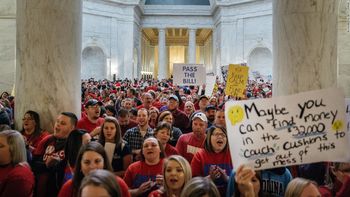The movement in West Virginia began when the deductibles and co-pays that public employees had to been when receiving health care began increasing. Health care benefits had recently begun to replace monetary raises for public school teachers in West Virginia, so when the deductibles began increasing, the teachers felt that they were really receiving no benefits from the state. In response to this a Facebook page titled "West Virginia Public Employees United" was created to help unite public employees across the state. People began posting their stories and raising awareness about the problems and by February the page had over 24,000 members. This allowed for ground-up organizing from individuals as well as members of unions just as the West Virginia Education Association and American Federation of Teachers. This helped spark the movement that would grow to include teachers and schools from all 55 counties in West Virginia, and eventually led to all public employees receiving a 5% raise, as mentioned earlier. After seeing the success of the West Virginia movement, a teacher in Oklahoma began a similar public Facebook page to the one the West Virginians used and it too grew very popular in a short amount of time. Through this Facebook page teachers from around the state participated in the same ground-up organizing and the strike followed shortly thereafter, leading to the teacher and teacher assistant raises.
In both Oklahoma and West Virginia the state legislators were initially resistance to the movement, urging teachers to go back to school immediately. However, as it became increasingly apparent that teachers in both states were not going to go back anytime soon and as the movements began to gain national media attention, the state governments eventually began to change their stance. The state government of West Virginia met all of the demands of the teachers, resulting in the salary increase for all state employees. In Oklahoma teachers and teacher assistants received raises, but the government refused to comply wit the demand the increase public school funding and also did not provide raises to all state employees. However, after the increase in salaries some government employees, specifically members of the State Legislatures in both states, remained critical of the decision, citing that the increase in teacher's salaries would likely result in money being cut from other parts of the government's budget such as Medicare and Medicaid, which many people utilize in both West Virginia and Oklahoma. However, West Virginia governor Jim Justice assured people that no money would be cut from the Medicaid or Medicare budgets. In Oklahoma, the funding for the raises will come from higher taxes on oil and gas production, tobacco, motor fuels, and online sales. Oklahoma will also allow for ball and dice gambling, which will be taxed.
The West Virginia strike was very successful with teachers receiving all their demands after being on strike for 9 straight days. Teachers and all state employees received a 5% pay increase. The strike in Oklahoma ended on April 12th, with teachers labeling the strikes as a partial success. Teachers will receive a pay increase of $6000 and teacher assistants receiving an increase of $1250. However no additional funding for schools will be provided in the state budget. The movements were also successful in generating new spaces for the everyday American who may feel that their voice or opinion cannot make a difference on a state or national level. Now people from guidance counselors to bus drivers to coal miners can move forward more confidently knowing that if they feel mistreated by their employers, there are actions that can be undertaken to generate real, tangible change

